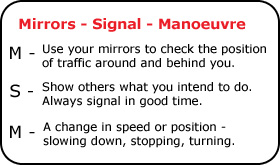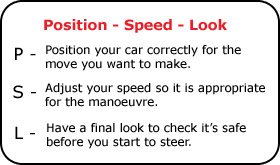How to Perform a Basic Right Turn
On your driving test, when performing a Basic Right Turn, the examiner will expect you to:
- Use the MSM/PSL routine in good time.
- Brake gently and in good time.
- Position your vehicle correctly – choose the correct lane where there are lane markings and in a one-way street.
- Look for obstructions, traffic and pedestrians.
The examiner will also be looking to see that you:
- Read stop signs, give way signs correctly, and in good time.
- Accurately assess the speed of traffic.
Dangers When Turning Right
Look out for vehicles nearing the end of the road you are turning into, and don’t cut the corner by turning too soon or too sharply, as this could put you into the path of the approaching vehicle.
When your view of oncoming traffic is restricted, say by bends or hill crests, be extra vigilant before making the right turn, as there may be an approaching vehicle just out of sight.
If a queue of vehicles is building up behind you, don’t get stressed or panic, as this may lead you to take an unnecessary risk and pull out too soon.
Pedestrians and Cyclists
You must give way to pedestrians crossing (actually crossing, not waiting to cross) any road you are turning into. If you encounter a pedestrian crossing the road, you must hold back until they are safely clear of your path.
Watch out for cyclists, motorcyclists, and pedestrians, as they are not always easy to see.



Mirrors
When you first see the junction, you should check your mirrors to assess the speed and position of the following traffic.
Signal
Indicate right to let other road users know you intend to turn right.
Position
Steer to take up a position as close to the middle of the road as is safe – normally just left of the centre of the road so that you may leave room for the following traffic to overtake you on your left.
Speed
When travelling slowly enough, select the appropriate gear.
Look
Look as far into the new road as you can, and ahead, to decide whether or not it is safe to proceed.
Priority
Traffic emerging from the side road should give priority to you. If you need to stop for approaching traffic, you must keep to your side of the road. Stop in position so the front of your car is just before the centre of the road you intend to turn into. Do not proceed until you are sure it is safe. If unsure, be patient and wait.
When safe to make the turn, steer smoothly so you end up in your normal driving position in the new road. Check your mirrors again to make sure it is safe to build up speed. Check to make sure your indicator has cancelled.
Point of Turn
You should begin turning into the side road in good time to avoid the danger of over-steering or clipping the kerb in the new road.
How soon you begin turning will depend on the widths of the roads you are leaving and entering and on what else you can see.
Move up to the point of turn and make sure you can see into the new road before turning. As a guide, the front of your car should be about level with the centre of the road you are joining before you begin the turn.
